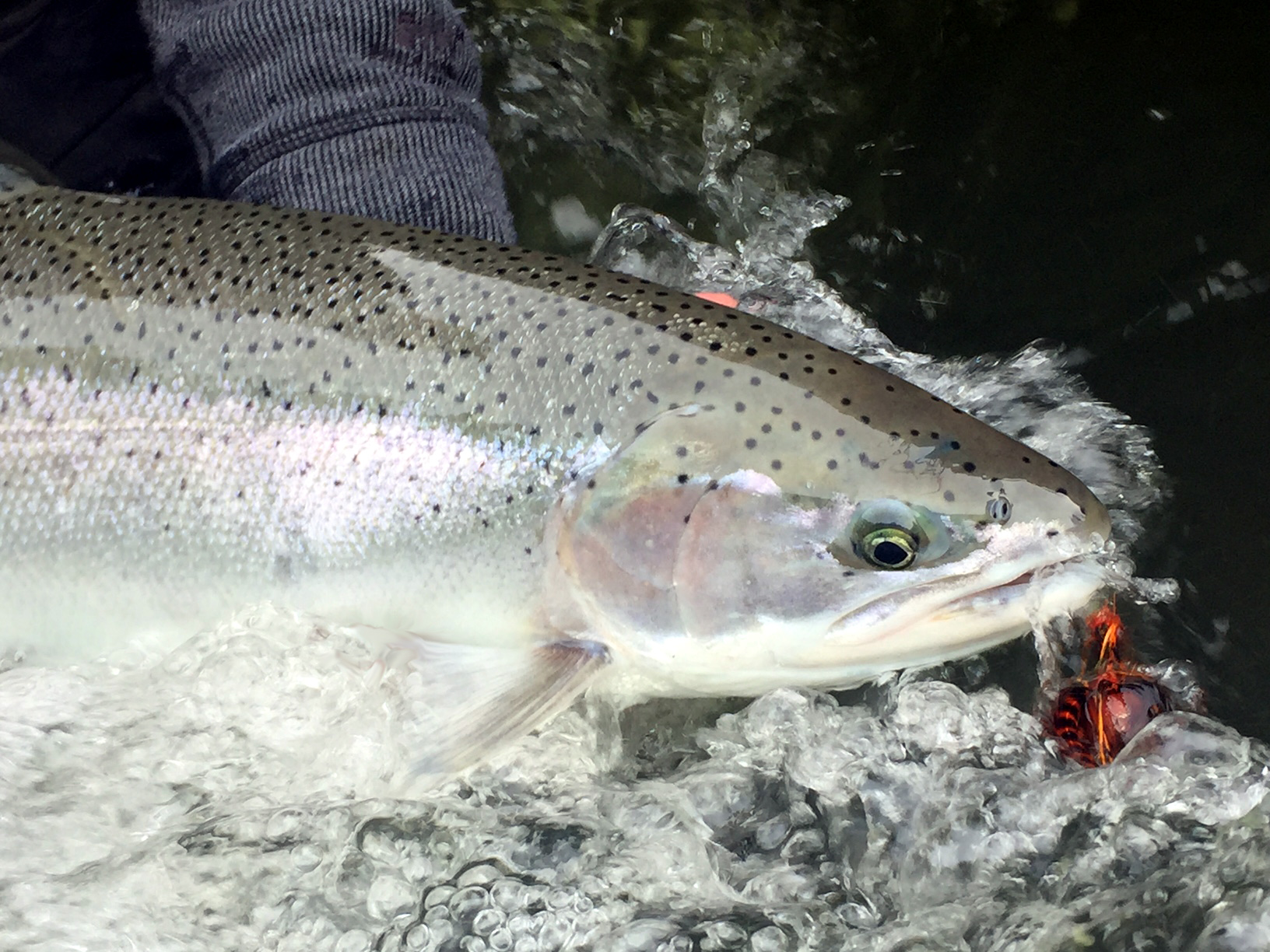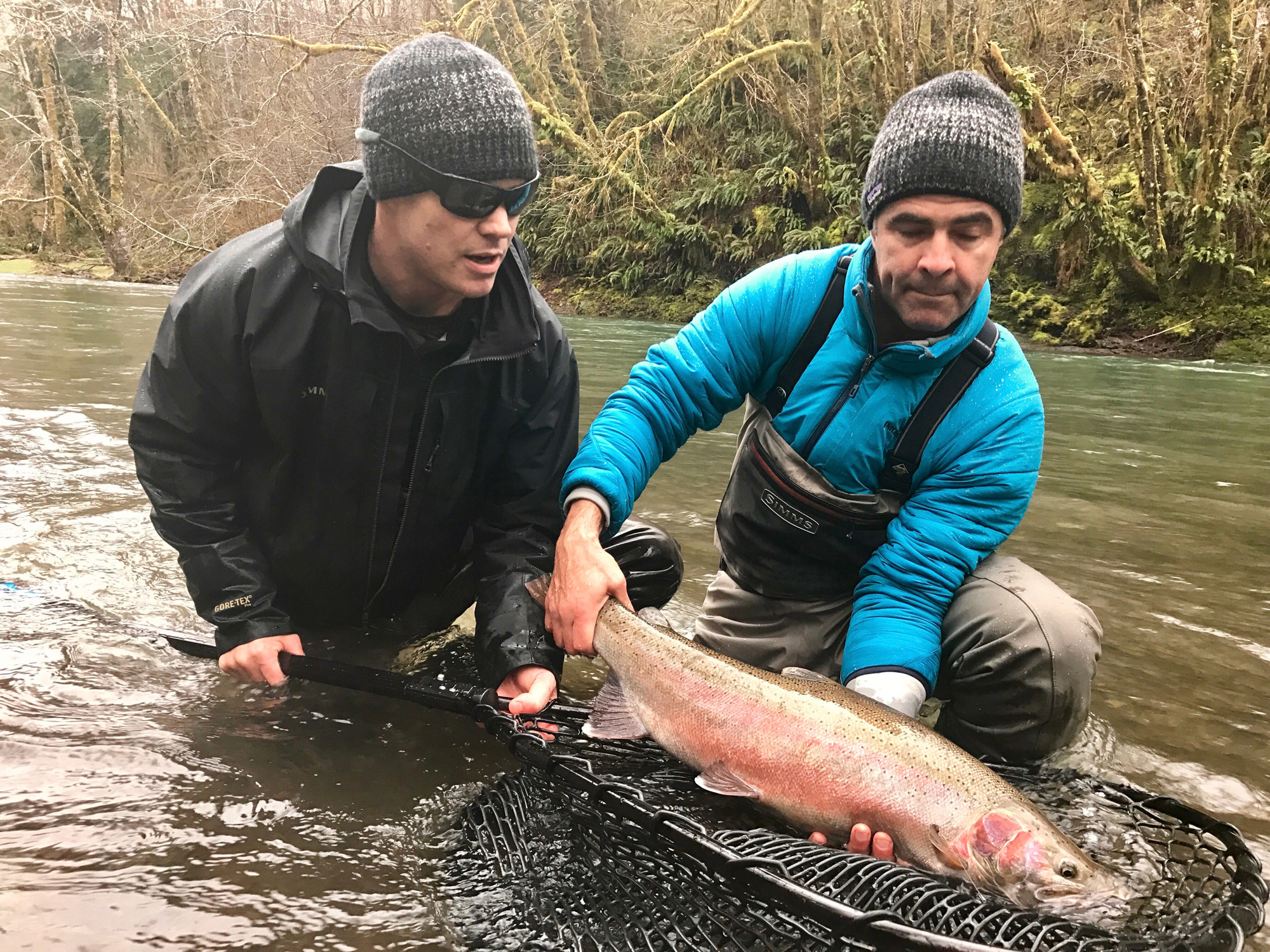Winter Steelhead Survival Guide
The 2017 winter steelhead season is in the books. And a memorable season it was, full of heavy weather, good fishing, and good times.
But to say the weather was heavy would be a gross understatement, and to say the fishing was good would be a little too generic. To say we enjoyed good times on the river, well that is pretty accurate!
For those who have not been anywhere near the Pacific Northwest this year, we have experienced an unprecedented amount of cold wet weather. Before the steelheading season even began I spent several days shoveling three feet of snow off my roof as buildings across Bend were collapsing under the frozen burden. That was a preview of what was in store for the coastal winter steelheading season. One after another the storms rolled in like clockwork from the Pacific with nothing to stop them from hitting the Coast Range Mountains square on. The rivers were swollen and teetering at their threshold for most of the winter season, often blowing out with little time to recover in between storms.
In addition to the battle against moisture, the temperatures of both air and water were significantly colder than usual. I can't recall how many days began with rain in Tillamook turning to snow once we climbed just a few feet above sea level. The kind of snow you get on the coast at 33 degrees. Big sloppy flakes that only stick because they fall so fast. If you're not wearing your hood and just one glop falls from a spruce tree down your neck - game over!
One thing I've learned this winter (and after a bleak 2016 summer steelheading season on the Deschutes) is where there is a fish there is a way. There were certainly fish around the North coast this winter. I heard quite a bit of scuttlebutt about lack of fish this season, mostly from anglers who depend on hatchery returns and huge catch rates and others whose normal winter fishing routine was interrupted by mother nature. We struggled at times but between this past winter and the winter before that I have had to dig deep and develop a high water program that satisfied both my clients and me. I feel fortunate to only have missed out on just a few days of guiding all winter.
When it comes to high water there are a few obstacles worth mentioning. The rivers are turbid and fast. Steelhead can see a lot better than we think though, so clarity is less of a problem than volume. Fishing pressure can also be a formidable problem as the options become limited... to find relative solitude there is no substitute for exploration and experience. An angler can also become their own worst enemy under adverse conditions. The tough mental game of winter steelheading gets even tougher when you are cold and wet and the forecast is grim.
Regarding turbidity I tend to use large and darkly colored flies (black, blue, purple) with broad shoulders that tell the steelhead to "piss off!" I'm talking as big as you can possibly cast. The problem is that many anglers are either not used to casting big flies or they just don't enjoy it. I get that, so this winter I tied a ton of flies that are basically Marty Shepard's Metal Detector. The main difference is that I used bead chain and lead eyes instead of a cone. What a great pattern! It is a simple dress using only three or so ingredients making for a quick tie. More importantly, two of the three materials used are resistant to holding water once they become airborne. Thanks for the killer guide fly Marty.
One common issue with casting big flies I see on a daily basis is anglers coming to the coast equipped with 450 grain heads. I get that you don't need a super heavy rod for steelhead in Oregon. But it's not always about matching your rod to the fish. You need to figure out what kind of flies and sink tips you should cast, then work backwards to the grain weight of your Skagit head, and finally figure out what rod that will require. I like to cast 525 grain and up, often 570 ish. I spent all winter casting Airflo's Skagit FIST head and am beyond impressed. The triple density head digs below the squirrely surface currents and really slows down the swing, especially when fishing slow water over faster water. At 23 feet it is shorter than I usually like to cast, but the sinking portions of the head seem to help stick the anchor. Sometimes there is no suitable alternative for a full floating head, but this winter I honestly felt naked in all but just a few scenarios without the FIST. I understand Brian Silvey had a lot if not everything to do with the FIST, so a shout out to the Silvenator for a wonderful gift to the winter steelheading community.
There is no way around high and fast water, no matter the clarity. Some runs fish better at high water than others, where the banks are more gently sloped and the extra volume has somewhere to go. The same is true for stretches of river. Some floats are better high water options than others. Most of the coastal rivers I fish have an average gradient of about 30 feet per mile, downright clipping at high water. But there are usually one or two spots on any given float that excel during these conditions. It seems that pound for pound these high water spots, however few and far in between they are, flat out produce.
I believe I understand as well as anyone that it isn't all about catching fish, and I'm fortunate that most of the anglers who fish with me are like minded. BUT... but an unavoidable part of my job description as a guide is to provide an edge for my clients that they may not have fishing on their own. Often this reduces down to intuition. On any given day it is incredible how many decisions a guide has to make. Over the years I have become a gambler when it comes to making decisions on behalf of my anglers. When you gamble you set yourself up for great success or epic failure. In my experience the payoffs win by a landslide. So at the beginning of an unlikely day decide what your bottom line is. Pick one or two spots you need to fish and go for it. If you can take care of business early the rest of the day is gravy.
Wearing quality layering, waders, and rain gear make standing in the cold and wet a reasonable proposition and help keep your head in the game. I started the 2017 season with a brand new pair of Simms G3 waders, a brand new Simms Slick Jacket, and a wool Patagonia beanie. One of my Kast steelhead gloves jumped out of the boat in one of the more puckering rapids early in the winter so I went back to my old reliable Filson wool fingerless gloves. As far as layering goes, I have not strayed from Icebreaker merino wool in years and still swear by the stuff. When you spend a lot of time in the elements, even with the best Gore-tex money can buy, staying completely dry is not an option. I am a big fan of layering that will keep you warm and function properly even when it gets wet. One last trick to keep my hands warm that I learned from my friend Dave Hess is to rub in a generous amount of A&D ointment first thing in the morning. The stuff has a strong smell to it and your hands feel all slimy at first but it only takes a few minutes to absorb. You will notice a huge difference in your hands and fingers, I guarantee it.
"Forget the forecast" has become a popular slogan among anglers in the Pacific Northwest. While this may seem cliche for a steelheader it has never been more evident than during the 2017 winter season.
Thanks for reading,
Chris











